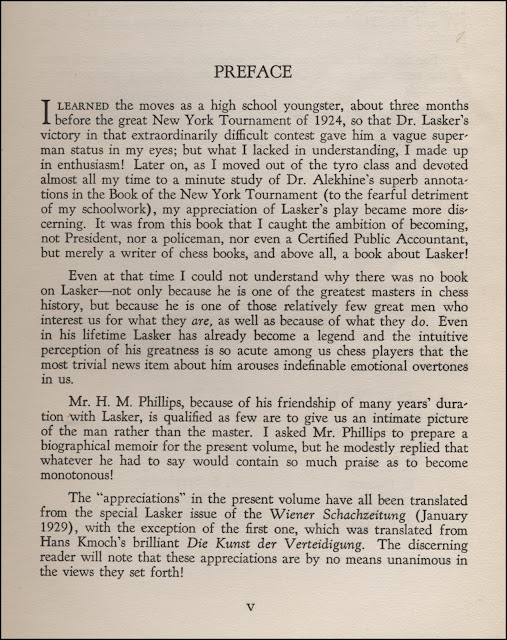The value of the scarce Part II of Steinitz's The Modern Chess Instructor, New York 1895, scaled new heights recently when a copy sold for €831 at the LSAK chess book auction earlier this month.
While the value of many collectable chess books has stagnated recently, the price of this particular item has risen inexorably over the last twenty years or so.
This is almost entirely due to the book's rarity, as this is simply a 64 page paperback openings book, (usually given a wide berth by collectors), covering the, less than exciting, Ponziani opening and the Giucco Piano. I do not have this book, I should make the effort to acquire the Olms reprint, but, no doubt, Steinitz's explanation of these openings is of some significance, especially if he continues the exposition of his theories on the game, which constitutes an important element of The Modern Chess Instructor, Part I, New York 1889.
This book turns up for sale from time to time and is usually sold with Part I. A copy was sold (with Part I) at the remarkable auction of chess literature held by Hauswedell & Nolte in Hamburg on 24th November 1995, when the pair fetched DM 500, the equivalent of about £225 at the time. The book was exaggeratedly described as "of the greatest rarity".
Dale Brandreth had a copy for sale, bound with Part I, in his List TMB-59 issued in July 2001. The price was $275 compared with $75 for Part I only and Brandreth stated "most copies were destroyed in a warehouse fire. Part II is exceedingly scarce".
International Chess Auctions in Ireland sold both Parts in February 2002 for €287 describing Part II as very scarce, and another pair was sold later that year in the Klittich-Pfankuch November auction for €220, Part II described as very rare.
Part II only was sold on Ebay in August 2008 for £272 and another copy (or maybe the same one) sold for €531 in the International Chess Auction held in February 2009. Parts I and II together were also sold in the Klittich-Pfankuch auction in November 2010 for €300 and for €340 in their November 2014 auction. The most recent sale was for €831 in the LSAK auction on 9th September 2017 as mentioned above.
Some earlier book sellers were aware of the book's scarcity; E. G. R. Cordingley calling this "exceptionally scarce" in his Catalogue No. 4, February 1936 and "the scarcest modern book on chess" in Catalogue No. 5, June 1936. He valued the book at 10/- compared with, for example, 7/6 for each of Mrs W. J. Baird's books, Seven Hundred Chess Problems, and The Twentieth Century Retractor.
The University Place Bookshop, New York, Catalogue No. XIII, 1937 described the book as "one of the scarcest modern works on chess", although the price differential was only moderate: Part I $2.50, Part II $4.75.
John Rather also described the book as "one of the scarcest chess books" in his List 82-A, 1982.
However, the book's scarcity was not always appreciated; Will H. Lyons advertised Part I for sale at $1.50 and Part II at 0.75c in his 1897 Catalogue No. 7, (perhaps the fire had not yet happened), and in the Antiquariatsliste Nr. 291 of N. V. Martinus Nijhoff's Boekhandel en Uitgeversmaatschappij, circa 1938, Parts I and II were sold together for Gld. 2.50.
The British Chess Magazine offered a small chess library for sale on page 76 of the February 1928 magazine, including The Modern Chess Instructor, Part I at 5/- and Part II at 2/- or 6/- the pair. The next month, it was announced, on page 106, that all of the books for sale were disposed of on the first morning and could have been sold ten times over.
Perhaps more surprisingly, Ken Whyld advertised both Parts I and II at 15/- each in his List No. 7 issued in 1954 when he sold off E. G. R. Cordingley's library, although he did describe Part II as very scarce.
© Michael Clapham 2017



















































